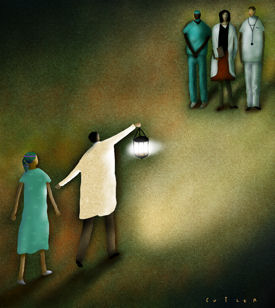New tool makes it easy to add crucial family history to EHRs
Electronic medical records are slowly pushing out the family history, eliminating valuable diagnostic information. But a free tool offers an easy way to restore important details to a clinician's files.
One of my pet peeves with electronic health records (EHRs) has been a lack of attention to collecting family history and generating medically useful information. Most EHRs provide only a text box for data collection. While a few systems collect structured data, that data can't move from system to system without using paper. I am unaware of any widely used system that can collect structured data and use it to generate a pedigree. EHRs are proposed as part of health care reform and even mandated to some extent for e-prescribing efforts. EHR's greater penetration in clinical care could potentially push family history from the medical record.
The inability to easily capture structured family history in electronic charts will impede the ability of health care providers to fully assess disease risk for many common conditions such as cardiovascular disease, diabetes, deep vein thrombosis and cancers. Such individualized risk assessment is a bedrock of the national movement toward personalized medicine, and without family history information well-validated tools such as the Framingham and Reynolds risk score for cardiovascular disease risk are considerably less accurate.

As well, the absence of family history severely affects the ability to properly order and interpret genetic tests for a wide variety of conditions. For example, genetic testing for hereditary breast and ovarian cancer syndrome is informed by family history, and usually the first person tested in the family is an affected family member rather than the patient at risk for breast cancer. The genetic test result from the affected family member is then used to guide testing for all other at-risk family members.
On my arrival at the National Human Genome Research Institute two years ago, it became apparent that an opportunity existed to help improve the collection of family history electronically through a workgroup of the American Health Information Community, a federal advisory committee. Much work since then by a team of dedicated individuals from government and the private sector has improved prognosis for family history in the age of digitized records.
The most important achievement of this work has been the development and vetting of now widely accepted standards for family history information in health information technology systems. The new standards define the basic elements of family history that EHR and personal health record systems should be able to capture, in what form it should be captured, and how the family history data should be moved between systems.
These standards provide a foundation for the development of health information technology systems with the ability to capture enough information to be clinically useful, share information between systems and help providers to interpret and act on family history information. Several major health care systems, including Intermountain Healthcare and Harvard-Partners, are already using the standards to gear up for exchange of family history information. Each have systems designed to help patients and providers interpret familial risk for disorders like breast cancer and cardiovascular disease.
In the last year, these standards have been put into practice through a public-private partnership (including, but not limited to, the U.S. Department of Health and Human Services, the Veterans Health Administration, Indian Health Services as well as Partners Healthcare and Intermountain Health Care) charged with creating a new version of the publically available, consumer-focused family history tool known as the U.S. Surgeon General's My Family Health Portrait (familyhistory.hhs.gov). Designed to facilitate consumer collection of family history information, the new tool offers increased flexibility for the user, while conforming to the standards outlined above. This means that the consumer can create a complete family history, store the information on his or her own computer, and then choose to upload the history file to a compatible personal health record or EHR. The tool is available in both Spanish and English, and the government Web site on which it runs does not store any user information.
Most importantly, the programming for the new tool is being made available free to any public or private health care entity with an interest in acquiring a better way to capture family history information. The tool is customizable, with the caveat that alterations must conform to the data standards on which the tool is based. The My Family Health Portrait program can download from the National Cancer Institute's Gforge Web site. Early adopters of the tool have included personal health record systems, as they can save considerable development costs by incorporating the tool en bloc as a client interface for family history.
If you have an EHR or personal health record portal in your practice setting, or are considering purchasing one, find out if the vendor has considered the new standards for family history. Ask if your system could make use of the new My Family Health Portrait tool, or a file produced by it. Additionally, find out whether the system conforms to emerging standards from the Health Informatics Technology Standards Panel and the Certification Commission for Healthcare Information Technology. If, not ask them why not, and what plans they have for developing the ability to share health information with other systems.
The stage has been set for the development of enhanced family history capabilities in EHRs and personal health record systems. You, as a user and purchaser of these products, can demand that this opportunity not be squandered.




